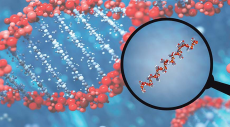

Post Transcriptional Regulation of Gene Expression
Topics discussed:
RNA editing
Ribozymes (catalytic RNAs)
Regulation of nuclear export of mRNAs
miRNA
What is RNA editing?
RNA editing is a mechanism of modifying RNA after it has been transcribed.
Mechanisms of RNA editing:
Base insertions (usually involves the insertion of uracil for example cytochrome oxidase III uracil insertions in Trypanosoma brucei)
Cytosine to uracil deamination
Adenine deamination to inosine
Editing of Apolipoprotein B – The Editosome
The editosome consists of a complex including APOBEC and ACF. This catalyses the controlled cytosine to uracil deamination in specific mRNA sequences. For example a deamination reaction in ApoB mRNA to control the association of LDL with LDL receptors. In the liver part of the sequence is CAA, but in the intestine, it is UAA, this difference means that LDL is not taken up by LDL receptors in the intestine.
Adenine deamination to inosine is catalysed by ADAR (adenine deaminase acting on RNA). This deamination reaction can influence the protein sequence.
Examples of adenine deamination to inosine
In the 3’ UTR region, mRNA encoding tankyrase can be edited modulating mRNA stability.
Editing of introns can have an influence on splicing.
Editing of exons encoding glutamate receptors and serotonin receptors modulate effects of receptors. Deamination of A to I regulates serotonin coupling efficiency. In glutamate receptors, calcium ion channel permeability can be modulated. Mice without ADAR are prone to epileptic seizures.
Possible explanations for why RNA editing has evolved
Well perhaps it is a system to revise mistakes. It could be a mechanism to enhance genome plasticity (adaptability), or a mechanism for developing viral resistance. It could be all 3 reasons.
What are ribozymes?
RNA molecules that have catalytic activity.
Examples of ribozymes:
There are self-splicing introns that therefore do not need the spliceosome (we have discussed splicing before but as a quick recap; splicing is the removal of non-coding RNA (introns) from coding RNA (exons.)
RNaseP is a ribozyme that cleaves the head from bacterial tRNA molecules to activate them.
Ribozymes have been implicated in the peptidyl transferase reaction occurring in ribosomes during translation.
There are different types of ribozymes, for example: hammerhead ribozymes, hepatitis delta ribozyme, and hairpin ribozymes. The Hammerhead ribozyme is RNA that catalyses reversible cleavage and ligation reactions at specific sites within an RNA molecule. Its name comes from its structural appearance resembling a hammerhead shark.
What is Ribozyme therapy?
A mechanism of using ribozymes to treat disease/ infection. For example, using ribozymes to edit genome containing HIV viral genome in CD4+ cells.
snoRNPs are small nucleolar ribonucleic proteins that guide chemical modifications to RNA sequence, for example guided methylation and pseudouridylation (converting pyrimidines into pseudouridine.)
Processed mRNA can be exported to the cytosol for translation, transport is in an energy dependent and active process.
What are miRNA? (microRNAs)
Short double stranded RNA sequences that are non-coding but can control gene expression. They are highly useful, and are used at various stages in development.
image-https://www.biovendor.com/mirna-summary

0 Comment:
Be the first one to comment on this article.